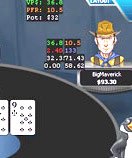Member Comments
No comments so far
 Not too long ago, the development team behind the popular poker tracking software Holdem Manager released an add-on that allowed for the import of Omaha hands. Whether it is Pot Limit Omaha, No Limit Omaha, Limit Omaha, or any of the High/Low varieties, the program imports hand histories and keeps track of a player's (and villains’) statistics. Just as important, Hold'em Manager with the Omaha Manager add-on features a Heads-Up Display (HUD) as an overlay on top of a table. Inside this HUD, a player can put any stat to reference how opponents act in certain situations.
Not too long ago, the development team behind the popular poker tracking software Holdem Manager released an add-on that allowed for the import of Omaha hands. Whether it is Pot Limit Omaha, No Limit Omaha, Limit Omaha, or any of the High/Low varieties, the program imports hand histories and keeps track of a player's (and villains’) statistics. Just as important, Hold'em Manager with the Omaha Manager add-on features a Heads-Up Display (HUD) as an overlay on top of a table. Inside this HUD, a player can put any stat to reference how opponents act in certain situations.
The difference between Hold'em and Omaha is far wider than most Hold'em players give credit for when they first migrate over. For starters, a great Hold'em hand like A-A is license to shove at any table in any situation. On the other side of the coin, in Omaha, a hand like A-A-6-9 rainbow might just be worth a call if the pre-flop action is multi-way with no hope for a 3bet to get anyone out of the pot. Why? Because against a wide field, the A-A-6-9 hand is basically drawing to top set or a boat against what has to be at least one or two decent rundowns that are actually favorites at that point in the hand.
An HUD for most players playing No Limit Texas Hold'em has several core elements that are universal to most HUDs. Those stats include VPIP (voluntarily put money into the pot), PFR (pre-flop raise %), AF (aggression factor), and Hands Played. This gives an immediate tell to the villain's pre-flop strategy in terms of how often they are in a pot and how often they are making a raise at this point in the hand. The AF is mainly used as a post-flop indicator as to how aggressively a player will play.
Other popular HUD stats for No Limit Texas Hold'em include 3bet (how often a player will make a 3bet), steal percentage (how often a player will make a steal raise when in the cutoff or button positions), fold to steal percentage (how often a player will fold versus a steal attempt), and WTSD (percent of the time that the player went to showdown). Although most of these stats are geared for pre-flop reads, they are usually interpreted well enough to get a solid read on a player throughout a hand.
What happens when a player moves from No Limit Texas Hold'em to Omaha is that they find their basic HUD stats don't carry over. Strangely, two phenomenons have crept up within the Omaha community:
1. Unlike Hold'em, there are no true "optimal" stats to have, as many different styles work successfully.
2. Most longtime online Omaha players just adopting Omaha Manager aren't going too in-depth with HUD stats and still just use them for basic reads.
The HUD landscape for Omaha players, at least for now, remains a mystery for core optimal stats to be used. However, many players across several forums are beginning to believe that street-based statistics are really what works best. For example, a regular player at the Pot Limit Omaha games with blinds of $0.50-$1 on the CEREUS Network divulged to us that some core stats are of tremendous importance for a general read. They include VPIP, PFR, WTSD, 3bet, and Hands. Beyond that, this Omaha rounder said that getting reads on each street was vital since most Omaha players at the micro- and small-stakes levels will fall into predictable patterns of post-flop play. The first type of pattern is the "Hold'em Homer" who stays true to their No Limit Hold’em ways and makes a pre-flop raise with a decent Omaha hand, gets called by one or two players, makes a continuation bet regardless of the flop, and then shuts down and give up.
Another type of player was called a "Die Hard" because he never gives up no matter what the odds might be. These players have ridiculous pre-flop numbers like 68/5 and post-flop numbers that show they never fold to any sort of bet – ever.
The best stats to use for the various streets (without having a ridiculous HUD of 76 stats on it) include "Agg pct" (Aggression Percentage), Street Cbet % (how often they are making a cbet on that particular street), and Fold vs Street Bet (how often they fold to a bet on that street). These stats show how willing and able a player is post-flop, where the major of the poker is played in Omaha.
Under this scenario, an Omaha HUD could look something like:
VPIP / FPR / WTSD / 3Bet / Hands
Agg % on Flop / Flop Cbet / Fold vs Flop Bet
Agg % on Turn / Turn Cbet / Fold vs Turn Bet
Agg % on River / River Cbet / Fold vs River Bet
Although this might be a very bulky HUD to load up on your poker table, it should fit fine, as most Pot Limit Omaha games are played in a six-max format. For now, the experimentation continues for the right Omaha HUD for the majority of players, but the distinction between a HUD for Hold'em and Omaha is as different as the strategies needed to be a winner at either game.
No comments so far